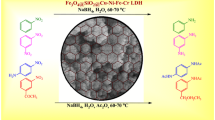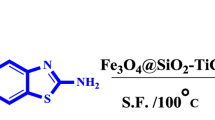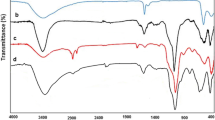Abstract
Magnetic core–shell nanomaterial Fe3O4–SiO2–Cu2O/Cu was first successfully synthesized using an economical strategy. Using Fe3O4 as a magnetic center for easy recycling and SiO2 as the connecting layer, Cu elements were evenly and steadily distributed on the surface of the Fe3O4–SiO2–Cu2O/Cu core–shell nanostructure. The magnetic catalyst performed outstanding catalytic reduction activity for 4-nitrophenol (4-NP), and the complete catalytic reduction of 4-NP was achieved within only 5 min. What’s more, the catalyst could be well recycled, and the catalytic efficiency remained more than 90% after being reused 24 times.
Graphical abstract








Similar content being viewed by others
Data availability
The authors confirm that the data supporting the findings of this study are available within the article and/or its supplementary materials.
References
Fatima R, Afridi MN, Kumar V, Lee J, Ali I, Kim KH, Kim JO (2019) Photocatalytic degradation performance of various types of modified TiO2 against nitrophenols in aqueous systems. J Clean Prod 231:899–912. https://doi.org/10.1016/j.jclepro.2019.05.292
Arora PK, Srivastava A, Garg SK, Singh VP (2018) Recent advances in degradation of chloronitrophenols. Bioresour Technol 250:902–909. https://doi.org/10.1016/j.biortech.2017.12.007
Hasan Z, Cho D-W, Chon C-M, Yoon K, Song H (2016) Reduction of p-nitrophenol by magnetic Co-carbon composites derived from metal organic frameworks. Chem Eng J 298:183–190. https://doi.org/10.1016/j.cej.2016.04.029
Yan J, Wang X, Gong P, Wang C (2021) Nitrated polycyclic aromatic compounds in the atmospheric environment: a review. Crit Rev Env Sci Tec 51:1159–1185. https://doi.org/10.1080/10643389.2020.1748486
Yang KC, Ji M, Liang B, Zhao YX, Zhai SY, Ma ZH, Yang ZF (2020) Bioelectrochemical degradation of monoaromatic compounds: current advances and challenges. J Hazard Mater 398:122892–122908. https://doi.org/10.1016/j.jhazmat.2020.122892
Yao L, Zhang L, Long B, Dai Y, Ding Y (2021) N-heterocyclic hyper-cross-linked polymers for rapid and efficient adsorption of organic pollutants from aqueous solution. J Mol Liq 325:115002–1115010. https://doi.org/10.1016/j.molliq.2020.115002
Liang W, Lu Y, Li N, Li H, Zhu F (2020) Microwave-assisted synthesis of magnetic surface molecular imprinted polymer for adsorption and solid phase extraction of 4-nitrophenol in wastewater. Microchem J 159:105316–105326. https://doi.org/10.1016/j.microc.2020.105316
Zhu X, Ni J (2011) The improvement of boron-doped diamond anode system in electrochemical degradation of p-nitrophenol by zero-valent iron. Electrochim Acta 56:10371–10377. https://doi.org/10.1016/j.electacta.2011.05.062
Singh S, Kumar N, Kumar M, Jyoti AA, Mizaikoff B (2017) Electrochemical sensing and remediation of 4-nitrophenol using bio-synthesized copper oxide nanoparticles. Chem Eng J 313:283–292. https://doi.org/10.1016/j.cej.2016.12.049
Xiong P, Fu Y, Wang L, Wang X (2012) Multi-walled carbon nanotubes supported nickel ferrite: a magnetically recyclable photocatalyst with high photocatalytic activity on degradation of phenols. Chem Eng J 195–196:149–157. https://doi.org/10.1016/j.cej.2012.05.007
Jiang X-H, Wang L-C, Yu F et al (2018) Photodegradation of organic pollutants coupled with simultaneous photocatalytic evolution of hydrogen using quantum-dot-modified g-C3N4 catalysts under visible-light irradiation. ACS Sustainable Chem Eng 6:12695–12705. https://doi.org/10.1021/acssuschemeng.8b01695
Karlova P, Gelbicova T, Sedlacek I (2016) Substrate interactions between 4-nitrophenol and 4-nitrotoluene during biodegradation of their mixture. Desalin Water Treat 57:2759–2765. https://doi.org/10.1080/19443994.2015.1071285
Wang Y, Hatt JK, Tsementzi D et al (2017) Quantifying the importance of the rare biosphere for microbial community response to organic pollutants in a freshwater ecosystem. Appl Environ Microb 83:1–19. https://doi.org/10.1128/aem.03321-16
Wang C, Zhang H, Feng C, Gao S, Shang N, Wang Z (2015) Multifunctional Pd@MOF core–shell nanocomposite as highly active catalyst for p-nitrophenol reduction. Catal Commun 72:29–32. https://doi.org/10.1016/j.catcom.2015.09.004
Chen H, Yang M, Tao S, Chen G (2017) Oxygen vacancy enhanced catalytic activity of reduced Co3O4 towards p-nitrophenol reduction. Appl Catal B-Environ 209:648–656. https://doi.org/10.1016/j.apcatb.2017.03.038
Chu C, Rao S, Ma Z, Han H (2019) Copper and cobalt nanoparticles doped nitrogen-containing carbon frameworks derived from CuO-encapsulated ZIF-67 as high-efficiency catalyst for hydrogenation of 4-nitrophenol. Appl Catal B-Environ 256:117792–117810. https://doi.org/10.1016/j.apcatb.2019.117792
Guo M, He J, Li Y, Ma S, Sun X (2016) One-step synthesis of hollow porous gold nanoparticles with tunable particle size for the reduction of 4-nitrophenol. J Hazard Mater 310:89–97. https://doi.org/10.1016/j.jhazmat.2016.02.016
Fu Y, Huang T, Jia B, Zhu J, Wang X (2017) Reduction of nitrophenols to aminophenols under concerted catalysis by Au/g-C3N4 contact system. Appl Catal B-Environ 202:430–437. https://doi.org/10.1016/j.apcatb.2016.09.051
Islam MR, Ferdous M, Sujan MI, Mao X, Zeng H, Azam MS (2020) Recyclable Ag-decorated highly carbonaceous magnetic nanocomposites for the removal of organic pollutants. J Colloid Interface Sci 562:52–62. https://doi.org/10.1016/j.jcis.2019.11.119
Bai Y, Wang Q, Du C et al (2019) Three-dimensional Cu/C porous composite: facile fabrication and efficient catalytic reduction of 4-nitrophenol. J Colloid Interface Sci 553:768–777. https://doi.org/10.1016/j.jcis.2019.06.079
Huang C, Ye W, Liu Q, Qiu X (2014) Dispersed Cu2O Octahedrons on h-BN Nanosheets for p-Nitrophenol Reduction. ACS Appl Mater Interfaces 6:14469–14476. https://doi.org/10.1021/am5037737
Jin L, He G, Xue J, Xu T, Chen H (2017) Cu/graphene with high catalytic activity prepared by glucose blowing for reduction of p-nitrophenol. J Clean Prod 161:655–662. https://doi.org/10.1016/j.jclepro.2017.05.162
Mandlimath TR, Gopal B (2011) Catalytic activity of first row transition metal oxides in the conversion of p-nitrophenol to p-aminophenol. J Mol Catal A: Chem 350:9–15. https://doi.org/10.1016/j.molcata.2011.08.009
Zhuang Y-T, Zhu T-T, Ruan M, Yu Y-L, Wang J-H (2017) A 2D porous Fe2O3/graphitic-C3N4/graphene ternary nanocomposite with multifunctions of catalytic hydrogenation, chromium (VI) adsorption and detoxification. J Mater Chem A 5:3447–3455. https://doi.org/10.1039/c6ta09774j
Chen G, Wang F, Liu F, Zhang X (2014) One-pot preparation of Ni-graphene hybrids with enhanced catalytic performance. Appl Surf Sci 316:568–574. https://doi.org/10.1016/j.apsusc.2014.08.047
Yeh C-C, Chen D-H (2014) Ni/reduced graphene oxide nanocomposite as a magnetically recoverable catalyst with near infrared photothermally enhanced activity. Appl Catal B-Environ 150–151:298–304. https://doi.org/10.1016/j.apcatb.2013.12.040
Cho D-W, Jeong K-H, Kim S, Tsang DCW, Ok YS, Song H (2018) Synthesis of cobalt-impregnated carbon composite derived from a renewable resource: Characterization and catalytic performance evaluation. Sci Total Environ 612:103–110. https://doi.org/10.1016/j.scitotenv.2017.08.187
Sheng J, Wang L, Deng L et al (2018) MOF-templated fabrication of hollow Co4N@N-doped carbon porous nanocages with superior catalytic activity. ACS Appl Mater Interfaces 10:7191–7200. https://doi.org/10.1021/acsami.8b00573
Sasmal AK, Dutta S, Pal T (2016) A ternary Cu2O-Cu-CuO nanocomposite: a catalyst with intriguing activity. Dalton T 45:3139–3150. https://doi.org/10.1039/c5dt03859f
Zhu XY, Qiao D, Yang LR et al (2021) Novel magnetic carbon supported molybdenum disulfide catalyst and its application in residue upgrading. Green Energy Environ 6:952–960. https://doi.org/10.1016/j.gee.2020.06.0252468-0257
Nikpassand M, Fekri LZ, Varma RS, Hassanzadi L, Pashaki FS (2021) Green synthesis of novel 5-amino-bispyrazole-4-carbonitriles using a recyclable Fe3O4@SiO2@vanillin@thioglycolic acid nano-catalyst. RSC Adv 12:834–844. https://doi.org/10.1039/d1ra08001f
Tago A, Yamauchi N, Nakashima K, Nagao D, Kobayashi Y (2021) Effect of silica-coating on crystal structure and magnetic properties of metallic nickel particles. Adv Powder Technol 32:4177–4185. https://doi.org/10.1016/j.apt.2021.09.023
Demin AM, Maksimovskikh AI, Mekhaev AV et al (2021) Silica coating of Fe3O4 magnetic nanoparticles with PMIDA assistance to increase the surface area and enhance peptide immobilization efficiency. Ceram Int 47:23078–23087. https://doi.org/10.1016/j.ceramint.2021.04.310
Ghimire PP, Jaroniec M (2021) Renaissance of Stober method for synthesis of colloidal particles: new developments and opportunities. J Colloid Interface Sci 584:838–865. https://doi.org/10.1016/j.jcis.2020.10.014
Gadah RH, Basaleh AS (2020) Influence of doped platinum nanoparticles on photocatalytic performance of CuO-SiO2 for degradation of Acridine orange dye. Ceram Int 46:1690–1696. https://doi.org/10.1016/j.ceramint.2019.09.141
Park J, Bae S (2019) Highly efficient and magnetically recyclable Pd catalyst supported by iron-rich fly ash@fly ash-derived SiO2 for reduction of p-nitrophenol. J Hazard Mater 371:72–82. https://doi.org/10.1016/j.jhazmat.2019.02.105
Yue Q, Li J, Zhang Y et al (2017) Plasmolysis-inspired nanoengineering of functional yolk-shell microspheres with magnetic core and mesoporous silica shell. J Am Chem Soc 139:15486–15493. https://doi.org/10.1021/jacs.7b09055
Wong A, Lin Q, Griffin S, Nicholls A, Regalbuto JR (2017) Synthesis of ultrasmall, homogeneously alloyed, bimetallic nanoparticles on silica supports. Science 358:1427–1430. https://doi.org/10.1126/science.aao6538
Bian T, Zhang J, Wang Z et al (2021) MoS2–induced hollow Cu2O spheres: synthesis and efficient catalytic performance in the reduction of 4-nitrophenol by NaBH4. Appl Surf Sci 539:148285–148292. https://doi.org/10.1016/j.apsusc.2020.148285
Jin J, Wu W, Min H, Wu H, Wang S, Ding Y, Yang S (2017) A glassy carbon electrode modified with FeS nanosheets as a highly sensitive amperometric sensor for hydrogen peroxide. Microchim Acta 184:1389–1396. https://doi.org/10.1007/s00604-017-2105-7
Jia W, Tian F, Zhang M et al (2021) Nitrogen-doped porous carbon-encapsulated copper composite for efficient reduction of 4-nitrophenol. J Colloid Interface Sci 594:254–264. https://doi.org/10.1016/j.jcis.2021.03.020
Qi J, Lan H, Liu R, Liu H, Qu J (2020) Efficient Microcystis aeruginosa removal by moderate photocatalysis-enhanced coagulation with magnetic Zn-doped Fe3O4 particles. Water Res 171:115448–115455. https://doi.org/10.1016/j.watres.2019.115448
Cychosz KA, Thommes M (2018) Progress in the physisorption characterization of nanoporous gas storage materials. Engineering-Prc 4:559–566. https://doi.org/10.1016/j.eng.2018.06.001
Kutluay S, Horoz S, Şahin Ö, Ekinci A, Ece MŞ (2021) Highly improved solar cell efficiency of Mn-doped amine groups-functionalized magnetic Fe3O4@SiO2 nanomaterial. Int J Energ Res 45:20176–20185. https://doi.org/10.1002/er.7097
Das AK, Kuchi R, Van PC, Sohn Y, Jeong JR (2018) Development of an Fe3O4@Cu silicate based sensing platform for the electrochemical sensing of dopamine. RSC Adv 8:31037–31047. https://doi.org/10.1039/c8ra05885g
Ren X, Tang L, Wang J et al (2021) Highly efficient catalytic hydrogenation of nitrophenols by sewage sludge derived biochar. Water Res 201:117360–117368. https://doi.org/10.1016/j.watres.2021.117360
Deka P, Deka RC, Bharali P (2014) In situ generated copper nanoparticle catalyzed reduction of 4-nitrophenol. New J Chem 38:1789–1793. https://doi.org/10.1039/c3nj01589k
Farooqi ZH, Sakhawat T, Khan SR, Kanwal F, Usman M, Begum R (2015) Synthesis, characterization and fabrication of copper nanoparticles in N-isopropylacrylamide based co-polymer microgels for degradation of p-nitrophenol. Mater Sci-Poland 33:185–192. https://doi.org/10.1515/msp-2015-0025
Kurnaz Yetim N, Aslan N, Koç MM (2020) Structural and catalytic properties of Fe3O4 doped Bi2S3 novel magnetic nanocomposites: p-Nitrophenol case. J Environ Chem Eng 8:104258–104268. https://doi.org/10.1016/j.jece.2020.104258
Liu Y, Lv M, Li L et al (2019) Synthesis of a highly active amino-functionalized Fe3O4@SiO2/APTS/Ru magnetic nanocomposite catalyst for hydrogenation reactions. Appl Organomet Chem 33:1–8. https://doi.org/10.1002/aoc.4686
Lin F-h, Doong R-a (2011) Bifunctional Au−Fe3O4 heterostructures for magnetically recyclable catalysis of nitrophenol reduction. J Phys Chem C 115:6591–6598. https://doi.org/10.1021/jp110956k
Kassem AA, Abdelhamid HN, Fouad DM, Ibrahim SA (2021) Catalytic reduction of 4-nitrophenol using copper terephthalate frameworks and CuO@C composite. J Environ Chem Eng 9:104401–104410. https://doi.org/10.1016/j.jece.2020.104401
Wi-Afedzi T, Kwon E, Tuan DD, Lin KA, Ghanbari F (2020) Copper hexacyanoferrate nanocrystal as a highly efficient non-noble metal catalyst for reduction of 4-nitrophenol in water. Sci Total Environ 703:134781–134788. https://doi.org/10.1016/j.scitotenv.2019.134781
Lin J-Y, Chen P-Y, Kwon E et al (2021) One-step synthesized 3D-structured MOF foam for efficient and convenient catalytic reduction of nitrogen-containing aromatic compounds. J Water Process Eng 40:101933–101941. https://doi.org/10.1016/j.jwpe.2021.101933
Wu Z, Zhu J, Wen W, Zhang X, Wang S (2022) Spherical covalent organic framework supported Cu/Ag bimetallic nanoparticles with highly catalytic activity for reduction of 4-nitrophenol. J Solid State Chem 311:123116–123123. https://doi.org/10.1016/j.jssc.2022.123116
Lin JY, Lee J, Oh WD et al (2021) Hierarchical ZIF-decorated nanoflower-covered 3-dimensional foam for enhanced catalytic reduction of nitrogen-containing contaminants. J Colloid Interface Sci 602:95–104. https://doi.org/10.1016/j.jcis.2021.05.098
Acknowledgements
We gratefully acknowledge the support from the National Natural Science Foundation of China (Grant No. 21605084), the Natural Science Foundation for Young Scholars of Jiangsu Province, China (Grant No. BK20160983), and supported by Research Start-up Funds for Talent Scholars of Nanjing Tech University (No. 39837104).
Funding
The funding was provided by National Natural Science Foundation of China (Grant No: 21605084)
Author information
Authors and Affiliations
Contributions
SS: Investigation, Data curation, Writing—review & editing. ZZ: Investigation, Data curation, Writing—original draft. SL: Investigation, Data curation. JL: Data curation, Writing—original draft. HQ: Investigation, Data curation. XY: Formal analysis. YL: Supervision. WY: Supervision, Visualization. YC: Conceptualization, Methodology, Funding acquisition. The authors confirm that they agree to submit the manuscript.
Corresponding author
Ethics declarations
Conflict of interest
We declare that we have no known competing financial interests or personal relationships that could have appeared to influence the work reported in this paper.
Additional information
Handling Editor: Dale Huber.
Publisher's Note
Springer Nature remains neutral with regard to jurisdictional claims in published maps and institutional affiliations.
Supplementary Information
Below is the link to the electronic supplementary material.
10853_2023_8377_MOESM1_ESM.doc
Supplementary file 1. The synthesis of Fe3O4 and Fe3O4-SiO2 are shown in the supporting information. Fig. S1 SEM images of (a) Fe3O4, (b) Fe3O4-SiO2 and (c) Fe3O4-SiO2-Cu2O/Cu composite. Fig. S2 (a) XRD, (b) FT-IR, (c) XPS full spectrum, (d) XPS local magnification spectrum of Cu 2p and (e) SEM of Fe3O4-SiO2-Cu2O/Cu composite after catalysis.
Rights and permissions
Springer Nature or its licensor (e.g. a society or other partner) holds exclusive rights to this article under a publishing agreement with the author(s) or other rightsholder(s); author self-archiving of the accepted manuscript version of this article is solely governed by the terms of such publishing agreement and applicable law.
About this article
Cite this article
Sun, S., Zhang, Z., Li, S. et al. Fabrication of recyclable magnetic Fe3O4–SiO2–Cu2O/Cu core–shell nano-catalyst for high-efficient reduction of aromatic nitro compound. J Mater Sci 58, 5587–5598 (2023). https://doi.org/10.1007/s10853-023-08377-8
Received:
Accepted:
Published:
Issue Date:
DOI: https://doi.org/10.1007/s10853-023-08377-8




